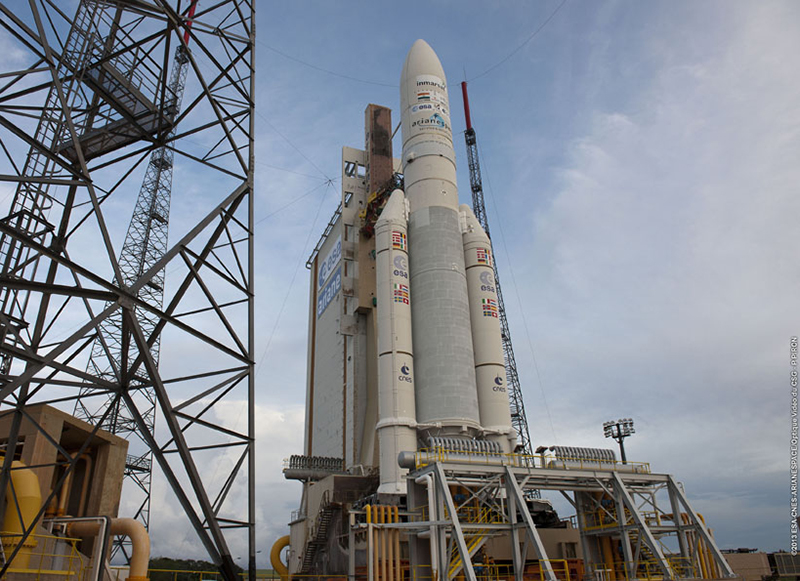
For the third time this year, another mammoth Ariane 5 booster has delivered a payload perfectly into orbit. Mission VA-214, the 214th flight by Arianespace’s rocket family since the maiden voyage of Ariane 1 in December 1979, roared away from the ELA-3 (Ensemble de Lancement Ariane) launch complex at the Guiana Space Centre in Kourou, French Guiana, on Thursday afternoon. A little more than 30 minutes after launch, VA-214’s twin cargoes—Europe’s powerful Alphasat communications satellite and India’s Insat-3D meteorological satellite—had been released from the final stage of the rocket and were undergoing checkout and preparation for delivery to their operational orbits.
Today’s flight follows hard on the heels of the launch of the Automated Transfer Vehicle (ATV)-4 “Albert Einstein” in June and the Amazonas-3 and Azerspace-1/Africasat-1A in February. The VA-214 launch campaign has proceeded without incident at the South American facility, with the erection of Ariane 5’s two stages in April and the arrival of the Alphasat and Insat-3D payloads in mid-June. Both satellites’ on-orbit propulsion systems were fueled in early July, and they were loaded aboard the rocket—with Insat atop the cryogenic core stage and Alphasat above it—ahead of “encapsulation” within the bullet-like payload shroud on 17 July. This intricate process took place inside the 295-foot Final Assembly Building (BAF) at the Guiana Space Centre.
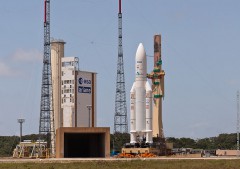
A standard Launch Readiness Review on Tuesday, 23 July formally cleared VA-214 and its payloads for flight, and the Ariane 5 stack began its rollout from the BAF, atop a mobile launch table, at 11:10 a.m. Kourou time (10:10 a.m. EDT) yesterday. The vehicle was “hard down” on the ELA-3 pad surface about 40 minutes later, and engineers set to work establishing electrical, fluid, and other connections. Earlier today (Thursday), final launch preparations shifted into high gear, and after weather checks the final authorization was given to begin loading 260,000 pounds of liquid oxygen and 50,000 pounds of liquid hydrogen into Ariane 5’s 100-foot-tall “cryotechnic main stage.” These propellants would feed the rocket’s French-built Vulcain-2 engine.
As the final minutes evaporated, weather conditions were described as “Fair” and all stations were listed as “Green.” At T-4 minutes, the propellant tanks were pressurized for flight and Ariane 5 transferred to its internal power supplies. In the last seconds of the countdown, the rocket’s on-board systems assumed primary control of all vehicle critical functions and the guidance system was unlocked to Flight Mode. Precisely on schedule, at 4:54:00 p.m. Kourou time (3:54:00 p.m. EDT), as the countdown clock hit T-zero, the Vulcain-2 ignited. A little over 7.5 seconds of engine-check operations were then conducted, ahead of the command to fire Ariane 5’s twin side-mounted solid-fueled boosters, each of which produces 1.4 million pounds of thrust. At this stage, at 4:54:08 p.m. Kourou time (3:54:08 p.m. EDT), VA-214 was committed to flight.
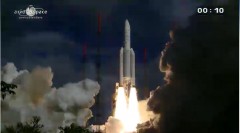
For the first five seconds of the ascent, Ariane 5 rose vertically, after which the two computers inside the Vehicle Equipment Bay (VEB) commenced a pitch and roll program maneuver, actively rotating the rocket toward the east and establishing it onto the proper flight azimuth to insert its twin satellite cargoes into orbit. A minute into the ascent, Ariane 5 had gone supersonic and soon afterwards passed through “Max Q,” the period of maximum aerodynamic stress on the airframe.
At T+142 seconds, the twin boosters were jettisoned, heading for a parachute-assisted splashdown in the Atlantic Ocean, about 300 miles east of Kourou. Meanwhile, the rocket had reached a velocity of 1,250 mph and continued to climb under the 300,000-pound impulse of the Vulcain-2 engine. At 4:57 p.m. Kourou time (3:57 p.m. EDT), about 3.5 minutes after liftoff, the bullet-like payload fairing was released, exposing Alphasat and Insat-3D to the harsh space environment for the first time.
The Vulcain-2 shut down and the first stage was discarded about nine minutes after launch, descending toward a splashdown zone off the coast of Africa, in the Gulf of Guinea. Meanwhile, the second stage—powered by a restartable, 6,100-pound-thrust Aestus engine—ignited at 5:03:04 p.m. Kourou time (4:03:04 p.m. EDT) to pick up the baton for the final push into orbit. By now, the rocket was over 105 miles high and traveling at more than 4,300 mph. Sixteen minutes later, having reached a velocity of 5,700 mph, Geosynchronous Transfer Orbit (GTO) was reached. At 5:21 p.m. Kourou time (4:21 p.m. EDT), Alphasat separated from the rocket at an altitude of 705 miles. Five minutes later, at an altitude of 1,350 miles, Insat-3D was deployed. Both satellites are currently undergoing systems and functionality checks, ahead of being maneuvered into their correct operational “slots.”
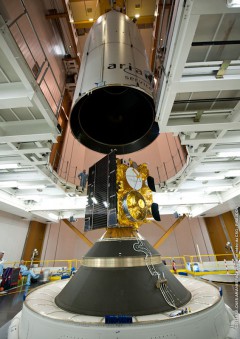
“This daylight launch provided an excellent view of the flight’s initial trajectory,” noted Arianespace on its website, “as the Ariane 5 began its vertical ascent, then rotated East—arching over the Spaceport’s main base area as it progressed downrange. The flight path was visible between a scattered cloud layers, and the clear meteorological conditions enabled an excellent view of the launch’s first phase—including separation of the two solid propellant boosters.”
Today’s mission marked the 70th launch of an Ariane 5, which first flew back in June 1996. Standing 171 feet tall and weighing close to 1.7 million pounds, the two-stage rocket is one of the world’s most powerful launch vehicles and has supported dozens of missions, only four of which have been classified as total or partial failures. On its ill-fated maiden voyage, it succumbed to a software glitch and was remotely destroyed by the Flight Termination System when it began to veer off-course. Its second launch in October 1997 also failed, due to a premature shutdown of its core stage, whilst two others in July 2001 and December 2002 also underperformed. However, Ariane 5 has maintained an unblemished record ever since. Key payloads delivered to space include the Envisat environmental monitoring platform, the Artemis telecommunications satellite, the Rosetta cometary science mission, and four Automated Transfer Vehicles (ATVs) to the International Space Station.
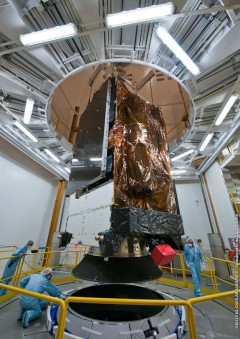
The two satellites lofted by VA-214 will play an enormously important role in their respective areas of telecommunications and meteorology. The inaugural contracts to build Alphasat were signed in Paris, France, between the European Space Agency (ESA) and the French Centre National d’études Spatiales (CNES) and the U.K.-headquartered International Maritime Satellite Organisation (INMARSAT) back in November 2007. It marked the first commercial customer to utilize the new “Alphabus” platform, which has been developed jointly by Astrium and Thales Alenia Space. The platform is described as “a co-ordinated European response to the increased market demand for larger telecommunications payloads for new broadband, broadcasting, and mobile communications services.”
In May 2009, Arianespace was chosen to launch Alphasat. The 14,600-pound satellite will be located at an inclination of 25 degrees East, from which it will spend up to 15 years providing extended coverage to Africa, Europe, the Middle East, and parts of Asia, supplementing INMARSAT’s 11-satellite current constellation. An advanced integrator processor provides payload flexibility and, coupled with its L-band transponder suite, enables robust communications in crisis and disaster emergencies, potentially connecting homes, schools, and businesses in remote locations.
Alphasat is equipped with a large deployable antenna reflector, measuring over 36 feet in diameter, and will also carry three ESA-supplied technology demonstrators. These include an advanced star tracker with active-pixel technology, an optical laser terminal for high-data-rate geosynchronous and low-orbit communications, and a dedicated payload to characterize performance in the Q-V band to prepare for possible future commercial exploitation. The satellite generates electrical power by means of two large gallium arsenide solar arrays, which have a total wingspan of 130 feet when fully unfurled in orbit.
Insat-3D carries advanced meteorological instruments, including a six-channel imager, a 19-channel sounder with C-band data-relay transponder, and satellite-aided search-and-rescue capability. The 4,400-pound satellite—based upon India’s I-2K “bus”—has been developed by the Indian Space Research Organisation (ISRO), headquartered in Bangalore. It was originally expected to fly aboard a home-grown Geosynchronous Satellite Launch Vehicle (GSLV), but in December 2010 ISRO decided to manifest it aboard an Ariane 5.
Its primary mission goal is “to provide an operational, environmental, and storm warning system to protect life and property and also to monitor Earth’s surface and carry out oceanic observations.” After insertion into geosynchronous orbit, at an altitude of more than 22,000 miles, Insat-3D will be maneuvered into its operational “slot” of 82 degrees, which will enable it to cover the entire Indian subcontinent. According to Shailesh Naik of India’s Ministry of Earth Sciences, the new satellite should “achieve more accuracy levels within a few years in short-term and long-term weather forecasts.”
The author would like to express his thanks to Mike Barrett and AmericaSpace’s Launch Tracker for the timely launch progress reports which contributed to this article.
Want to keep up-to-date with all things space? Be sure to “Like” AmericaSpace on Facebook and follow us on Twitter:@AmericaSpace




Now maybe you guys could help me out with something.
It seems like payloads are just getting larger and larger:
http://www.aviationweek.com/Blogs.aspx?plckBlogId=Blog:04ce340e-4b63-4d23-9695-d49ab661f385&plckPostId=Blog%3A04ce340e-4b63-4d23-9695-d49ab661f385Post%3Aa7cb6aee-1c4e-406a-a022-7b7fb65dee07
And yet there is this move to axe Ariane 5 for Ariane 6. I think Musk wrote his article against propping up Ariane 5 not because it was a bad idea, but because it was the only other rocket out there that was really a threat to him. Ariane 6 seems less capable. I think the Germans were right in keeping Ariane 5 and pushing for it.
R-7 is the defacto Ariane 4 mid-range title holder. I guess the Euros are scared of it and want an all Euro stable, with Vega and the Ariane 6.